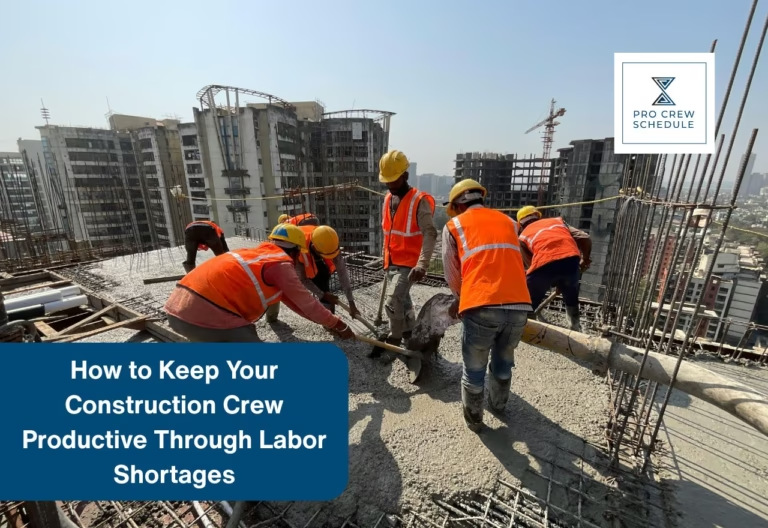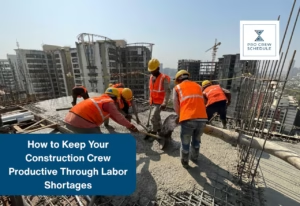No doubt, the success of a construction project can be attributed to the productivity of the people working on the site. However, being highly productive does not just mean working hard to complete tasks efficiently and deliver results on time. Even as a new project manager or a seasoned general contractor, managing your workforce is easier said than done. It requires creating a balance between boosting productivity and maintaining the well-being, health, and happiness of your employees.
The construction industry is a very fast-paced. Deadlines, budgets, and deliverables are often used as key performance indicators that measure production. However, more than just the numbers, real output is achieved when efficiency and the health and happiness of workers work in tandem. A team that is happy, motivated, and encouraged is more resilient, creative, and productive in the long run.
Inefficient crew management comes at a high cost. Bottlenecks can lead to expensive delays, project overruns, and ultimately result in less money in your pocket. Over the years, headlines have been full of stories about rising demand, changing material prices, and shortages. The construction industry is constantly changing, and general contractors must adapt to these shifts.
In this blog, we outline some strategies that can help you maximize employee productivity, including the effective use of technology, improved communication, stricter safety protocols, and fostering a positive work environment.
What Causes the Construction Labor Shortage?
In recent years, the construction industry has faced its share of challenges and pressures. Many people do not return to the construction industry because there are more job opportunities available in other fields. Contractors are continuously struggling to find workers and will need at least thousands more to complete and deliver projects on time.
With the rising labor shortages, costs rise, projects are delayed, and worker safety is compromised. Contractors may turn down work because they lack sufficient staff. As a result, budgets, quality, and production all decline. When projects are late, it affects budgets, earnings, and client satisfaction.
This can be attributed to aging labor, with the count of construction workers over 55 and approaching retirement age almost doubled in the past few years. Schools are struggling to attract more young people to the construction industry due to a lack of workers. They still have to deal with problems such as meeting project goals, preventing employee burnout, and generating revenue.
On the other hand, only a small percentage of the younger generations are considering working in construction as a career option. The good news is that younger people considering a career in construction are more focused on improving the way construction management is done. They are moving away from older technologies and traditional methods, such as using spreadsheets and performing tasks manually. With the help of construction technology, this problem can be transformed into an opportunity. Crew members need to learn new skills in areas like AI, analytics, and software used for managing building projects.
Tips for Dealing With Labor Shortages
Several steps need to be taken to address the shortage of building workers.
Fostering a Healthy Workplace
You need to take a deeper look at your business to determine how it is set up for work. When employers set unrealistic goals and require excessive hours, workers may not feel safe, valued, or supported. People will leave their jobs more often, and less work will get done in the long run.
Review How Pay Works
Pay is what motivates people in any career, regardless of the field. Construction sites often hire a large number of contract workers due to the nature of the work. It’s typical for businesses to treat these workers differently from full-time employees. Still, it’s essential to take a step back and examine current practices, as these distinctions can sometimes be a significant reason why productivity declines.
Be Inclusive
The construction business also experiences low worker productivity due to a lack of diverse worker types. To keep employees engaged, the team needs to be diverse and inclusive. Many people work in construction, and recruiting individuals from diverse backgrounds, nationalities, and religions can help them feel a sense of belonging.
Invest in Tools and Equipment
Employees need to have the necessary tools and technologies to accomplish their tasks effectively. In the construction industry, where occupations often involve a great deal of physical labor, providing workers with the correct tools has a direct impact on their productivity.
Provide Skill Development and Training
Companies also need to invest in training their personnel on how to use tools and technologies effectively on the job site. Failing to provide employees with the necessary training and information will not only slow down productivity but also waste resources.
Employees feel more valued when they have the opportunity to advance in their jobs and receive better opportunities. This helps you address the shortage of construction workers by motivating them and fostering their loyalty to the brand.
Utilize Construction Technology
Many construction technologies today are designed to simplify construction management. There aren’t enough people working in the building sector, but AI is helping to fill that void. Drones and robots make job sites safer and help people complete tasks more efficiently. Construction technology could help compensate for the lost production in the business due to a lack of personnel.
Entice the Next Generation
When there are not enough workers, technology can enhance procedures and help businesses compete more effectively. However, it is equally important to hire individuals from the following age group. There are more projects to create, hence more personnel are needed to work on them.
Teach young people about the fulfilling aspects of working in construction. This helps people find better jobs and addresses the need for qualified personnel in the building industry. People can learn about this vital profession in high school and at a technical college. Improving relationships with the media is also a good way to attract more young people to the construction industry.
Ways to Maximize the Productivity of Construction Workers
It may seem like a significant problem that the workforce is changing, but workers can adapt to it. Through strategic building project management, here are five ways to deal with these changes.
Centralize Your Data
Maintaining and managing data requires a significant amount of time. It is one of the most challenging aspects of managing workforce productivity. Spreadsheets that are only handled by one person have a single point of failure. This can be a significant problem if the person is sick, if the spreadsheet is complicated for others to understand, or if everyone is reviewing it and trying to decipher its meaning.
Centralizing your data is the first step to maximizing the potential of your construction workers. Putting all of your crew’s information on one platform that everyone can access provides everyone with the knowledge they need to make informed choices.
Efficiently Allocate Your Resources
One of the common issues in the construction industry is inefficient staffing and unequal distribution of work. These can hinder your teams’ ability to perform their jobs effectively.
When you have a large team working on multiple projects, it can be challenging to keep them all organized and coordinated. Having a centralized system, such as a construction crew management software, allows us to see everything at once.
Plan Ahead
A lack of accurate forecasting data is a common issue that hinders the ability to maximize the potential of construction workers. If your contractors and tradespeople are not in the right place at the right time, you might not have enough staff during busy periods or too many on one job site at the cost of another.
Keep Track of the Performance
Using management software enables you to manage and monitor your workforce’s analytics and efficiency metrics, which is crucial for tracking and improving performance.
At this point, keep an eye on key usage indicators. To track the growth in efficiency of your staff over time, you can do this both in real-time and retrospectively. You can even start looking at travel times and how well different areas work together to find the best way to use the workforce. This will allow you to adjust how resources are utilized based on their effectiveness.
Be Open to Change
There is always room for improvement, and as a result, you should continually strive to enhance your project management skills. A changing population will continue to change in the future, as will new technologies and the overall state of the economy. To stay at the top of your game, always stay informed about the latest developments in the construction industry, particularly in terms of emerging technologies and best practices that address new challenges.
Invest in A Construction Management Software
Using new technologies at work can significantly increase the efficiency of construction work. Construction companies can streamline project workflows, identify productivity issues, and implement solutions more efficiently. It can enhance workflows, simplify employee management, centralize paperwork, and minimize manual reporting. All of these factors can significantly improve the productivity of your team and, ultimately, the success of your construction project.
Give Credit Where Credit is Due
In the construction industry, workers are more productive when they know their efforts are appreciated. If you want your workers to know that you appreciate their hard work, they need to hear it from you. It makes people feel better about themselves and motivates them to be more committed and productive.
Key Takeaway
The shortage of construction workers is both a problem and an opportunity for those in charge of the industry. It will be hard to keep up with the rising demand if you do not adopt new strategies. If you take the time to change how you handle projects, you can make them more successful and run more smoothly than ever before.
To stay ahead of the competition, it is crucial to maintain higher building productivity levels than your competitors. People on the building site need to be aware of any problems that might be stopping them from doing their best work. You should continually train your employees and provide them with the necessary tools to enhance their productivity and effectiveness.







